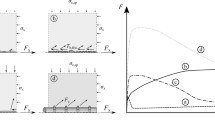Abstract
A new experimental approach that allows separation of the components of the Pickett effect due to surface microcracking and stress-induced shrinkage is developed and demonstrated for early age concrete subjected to tensile loads induced in restrained shrinkage tests. The experiment measures creep of three concree materials subjected to same loads, but under different environments: moist-cover, sealed, and drying conditions. The key features of the experiment are the suppression of shrinkage in the moist-cover test, and the uniform internal drying in the sealed test. The results confirm that the Pickett effect in tension has two sources: stress-induced shrinkage and microcracking. The new approach provides insght to creep, shrinkage, softening, and cracking behaviour under tensile load, and explains behavioral differences between plain and fiber reinforced concrete.
Résumé
Une nouvelle approche expŕimentale permettant la séparation des composants de l'effet de Pickett dû à la microfissuration extérieure et au retrait provoqué par la traction est développée et démontrée pour le béton au jeune âge soumis à traction lors d'essais sous retrait restreint. L'expérience mesure le fluage de trois matériaux à base de béton soumis aux mêmes chargements, mais sous différents environments, à savoir en condition d'humidité, en condition étanche et en condition de séchage. Les principales caractéristiques de l'expérience sont la suppresion du retrait dans l'essai en conditions d'humidité et le séchage interne uniforme dans l'essai en condition étanche. Les résultats confirment que l'effet de Pickett en traction a deux sources: le retrait provoqué par la traction et la microfissuration. Cette nouvelle approche fournit un aperçu sur le fluage, sur le retrait, sur le radoucissement et sur les comportements de déformations sous chargement en traction, et elle explique les différences de comportement entre le béton normal et le béton renforcé de fibres.
Similar content being viewed by others
References
Pickett, G., ‘The effect of change in moisture content on the creep of concrete under a sustained load,’ACI Journal 38 (1942) 333–356.
Bažant, Z. P. and Chern J. C., ‘Concrete creep at variable humidity: constitutive law and mechanisms,’Mater. Struct. 18 (103) (1985) 1–20.
Bažant, Z. P. and Chern J. C., ‘Strain-softerning with creep and exponential algorithim,’Journal of Engineering Mechanics ASCE 111 (3) (1985) 391–415.
Bažant, Z. P. and Chern J. C., ‘Stress-induced thermal and shrinkage strains in concrete,’Journal of Engineering Mechanics ASCE 113 (10) (1987) 1493–1511.
Bažant, Z. P. and Xi, Y., ‘Drying creep of concrete: constitutive model and experiments separating its mechanisms,’Mater. Struct. 27 (1994) 3–14.
Wittmann, F. H. and Roelfstra, P. E., ‘Total deformantion of loaded drying concrete,’Cement and Concrete Research 10 (1980) 601–610.
Wittmann, F. H., ‘On the influence of stress on shrinkage of concrete,’ in Creep and Shrinkage of Concrete,’ Proceedings of the Fifth International RILEM Symposium, Bažant Z. and Carol I. (eds), E & FN SPON, New York, 1993, 151–157.
Reid, S. G., ‘Deformation of concrete due to drying creep,’ in Creep and Shrinkage of Concrete,’ Proc of the Fifth International RILEM Symposium. Bažant Z. and Carol I. (eds.) E & FN SPON, New York, 1993, 39–44.
Bažant, Z. P. (Editor), ‘Mathematical modeling of creep and shrinkage of concrete’, John Wiley and Sons Ltd., 1988.
Kovler, K., ‘Interdependence of creep and shrinkage for concrete under tension,’ACI Materials Journal 7 (2) (1995) 96–101.
Altoubat, S. A. and Lange, D. A., ‘Creep, shrinkage and cracking of restrinal concrete at early age’,ACI Materials Journal 98 (4) (2001) 323–331.
Altoubat, S. A. and Lange, D. A. ‘Tensile basic creep: measurements and behavior at early age’,ACI Materials Journal 98 (5) (2001)
Altoublat, S. A., ‘Early age stresses and creep-shrinkage interaction of restrained concrete’, Ph.D. thesis in the Department of Civil Engineering at the Univ. of Illinois Urbana-Champaign, 2000.
The Math Works, INC, ‘MATLAB’ Natick, Massachusetts, 1997.
Bažant, Z. P. and Raftshol W. J., ‘Effect of cracking in drying and shrinkage specimens,’Cement and Concrete Reseach 12 (2) (1982) 209–226.
Alvaredo, A. and Wittmann, F. H., ‘Shrinkage as influenced by strain softening and creep formation,’ in Creep and Shrinkage of Concrete’, Proc. of the 5th International RILEM Symposium, Bažant and Carol, ed, E & FN SPON, New York, 1993, 103–113.
Author information
Authors and Affiliations
Additional information
Editorial Note Prof. David A. Lange is a RILEM Senior Member. He participates in the work of RILEM TC 181-EAS ‘Early age shrinkage induced stresses and cracking in cementitious systems’.
Rights and permissions
About this article
Cite this article
Altoubat, S.A., Lange, D.A. The Pickett effect at early age and experiment separating its mechanisms in tension. Mat. Struct. 35, 211–218 (2002). https://doi.org/10.1007/BF02533082
Received:
Accepted:
Issue Date:
DOI: https://doi.org/10.1007/BF02533082




